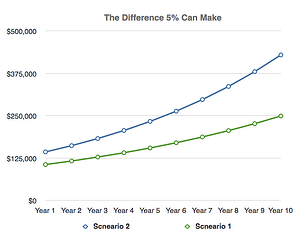It occurred to me yesterday that I’ve been writing a lot about the dangers of letting price competition damage your positioning and your margins, but I haven’t written much about the mechanics of protecting, and even raising your prices in markets like the one we’re in. So, today I’m going to share with you a specific example of how to enhance your margins.
First, you need to understand that you there are only two sales conversations you can be in:
- The What’s It Cost Conversation or
- The What’s It Worth Conversation
If you’re not sure which conversation you’re having, then you’re having The What’s It Cost Conversation. In my experience, 95% of sales conversations are in the “what’s it cost” category.
When your sales process is focused on your solution, it is difficult to impossible to escape “what’s it cost.” The reason for this is:
- The focus quickly goes to product/service features, attributes, and benefits; which naturally connect to costs.
- This focus naturally sets you up to be compared to other "solutions."
- Further, because the focus is solutions oriented instead of diagnostically oriented, you must deal with a misunderstood or not fully understood problem. This often makes the comparison unfair and further commoditizes you.
- When this happens, you fall into the deadly specs/price trap. Think about what you want when you're searching for solutions. We all want the solution that is good enough at the lowest price possible
It is far more effective, and profitable, to get into the "what's it worth" conversation. To do this, you must change the focus of your efforts from a solutions focus to digging deeper on problems. As you begin to probe the problem and dig deeper, you can begin to monetize the value of your solution. In essence, I'm asking you to begin pricing the problem - not the solution.
Let me share a real life example to illustrate my point. At Imagine, we solve sales problems. We could easily be compared to a variety of training "solutions," but a) what we do isn't really training, and b) that would badly commoditize us.
Instead, we help our prospects and clients first understand their problem and understand the cost of the problem. In our business, like many of yours, we face a challenge that the difference between our approach and our competitors is not huge. We're all saying many of the same things. These little differences, however, are huge when in comes to the results companies can enjoy.
So, to gain the price advantage that our results create, we must enable our clients to uncover just what the value difference is. That's precisely what "pricing problems" and monetizing value does. Here's how we do it:
Baseline Scenario
Let's say that your sales team produces the following:
- They average 40 proposals
- They average a 40% close rate
- So they're closing 16 new opportunities on average
- The average sale was $30,000
- Average gross margin of 22%
This means that each salesperson is producing (on average) $480,000 in sales and $105,000 in gross profit.

The Little Difference
Let's say that as a result of working with us you improve your results by just 5%. Now keep in mind, that a 5% difference is virtually imperceptible. But, this virtually imperceptible difference can lead to extraordinarily valuable results this 5% difference means:
- Instead of 40 proposals you average 42
- Instead of a a 40% close rate, you average 42%
- Instead of average $30,000 per sale, you average $31,500
- Your margins would go from 22% to 26%
- Total sales would be $555,000, up from $480,000
- Most powerfully, your gross profit you go from $105,000 to more than $142,000 - a 35% difference.
Now, if you maintained this performance improvement, you'd grow faster. So instead of growing at say 10% per year you'd grow 12.5% per year. That difference over a 10 year period of time would result in an increased gross profit of just under $1 million.
I ask you, what would that be worth?
With the problem fully understood and, more importantly, the cost of the problem clear, the proper context has been created to enable you to effectively discuss the appropriate solution (yours) and to have the solution properly valued.
My be is that your business and your approach create such value for your customers/clients. However, if you don't build out your business case to enable customers to understand the value of your difference, it can't be valued and your profits will suffer as a result.

 Doug Davidoff
Doug Davidoff